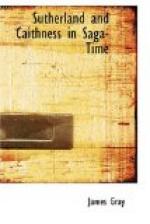In the reign of Constantine II, Kenneth’s son and next successor but one, further incursions by the Northmen took place under King Olaf the White of Dublin in 867 and 871; while in 875 his son Thorstein the Red, by Aud “the deeply-wealthy” or “deeply-wise,” landed on the north coast, and, we are told, seized “Caithness and Sutherland and Moray and more than half Scotland,"[4] being killed, however, by treachery within the year. His mother Aud thereupon built a ship in Caithness, and sailed for the Faroes and Iceland with her retinue and possessions, marrying off two grand-daughters on the way, one, called Groa, to Duncan, Maormor of Duncansby in Caithness, the most ancient Pictish chief of whom we hear in that district, and probably ancestor of the Moldan, or Moddan, line in Cat. Two years later, in 877, King Constantine was defeated by a force of Danes at Dollar, and slain by them at Forgan in Fife.[5]
After the great decisive battle of Hafrsfjord in Norway in 872, because Orkney and Shetland and the Hebrides had become refuges for the Norse Vikings, who had been expelled from their country or had left it on the introduction of feudalism with its payment of dues to the king, but were raiding its shores, Harald Harfagr,[6] king of Norway, along with Jarl Ragnvald of Maeri attacked and extirpated the pirate Vikings in their island lairs; and, as compensation to the jarl for the loss of his son Ivar in battle, Harald transferred his conquests with the title of Jarl of Orkney and Shetland to Ragnvald, who, in his turn, with the king’s consent, soon made over his new territories and title to his brother Sigurd.
This new jarl, the second founder of the line of Orkney jarls, conquered Caithness and Sutherland as far south as Ekkjals-bakki,[7] which is believed by some to be in Moray, and by others, with more truth, to be the ranges of hills in Sutherland and Ross lying to the north and to the south of the River Oykel and its estuary, the Dornoch Firth; and the second part of the name still happens to survive in the place-name of Backies in Dunrobin Glen and elsewhere in Cat where the Norse settled. About the year 890,[8] after challenging Malbrigde of the Buck-tooth to a fight with forty a side, to which he himself perfidiously brought eighty men, Sigurd outflanked and defeated his adversary, and cut off his head and suspended it from his saddle; but the buck-tooth, by chafing his leg as he rode away from the field, caused inflammation




